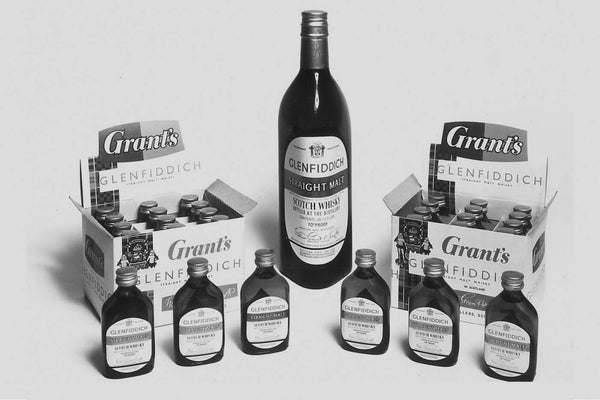The single malt renaissance (1950s to 1980s)
Aug 16, 2023
Single malt Scotch whiskies were readily available in British towns and cities in Victorian times. Brands such as Royal Brackla, Glen Grant and Long John’s Dew of Ben Nevis became well-known there and overseas, and were widely advertised in newspapers and journals (see here for examples).
By the 1920s, however, blended Scotch had come to dominate the world market. Bottled single malts became difficult to find and largely unappreciated outside Scotland.
Despite their scarcity, single malts retained a small but loyal following. Influential authors such as George Saintsbury, Neil Gunn and Robert Bruce Lockhart lauded them in print, while independent bottlers such as Elgin’s Gordon & MacPhail and Campbell, Hope & King, and Aberdeen’s William Cadenhead’s, continued to meet a limited but profitable demand from aficionados.
Then, in the late 1950s, came an irresistible surge in interest and demand.
There were a number of factors behind the single malt renaissance. One was the reaction from many whisky connoisseurs against the fashion for blended Scotches with less distinctive flavours. These lighter whiskies were introduced to satisfy the prevailing popular taste for more neutral-flavoured spirits such as vodka, and to emulate the phenomenal success of blends such as J&B and Cutty Sark in the USA.
For some critics, the spectacular post-war growth in whisky sales had been achieved by diluting the distinctive character of Scotch. George Grant of Glenfarclas summed up the feelings of the critics in 1971, claiming that "single malts are doing so well as a reaction against the lightness of the standard blends. Some blended whiskies are so light that by the time you put in ice there’s no taste left." The journalist John McPhee was less diplomatic (and certainly more prone to gross generalisation!), when he condemned blended Scotches as "bland and facile".
There was also the thorny issue of image. By the beginning of the 1960s, the leading brands of blended Scotch were turning away from the kitsch ‘heather and Harry Lauder’ imagery of old. The aspirational lifestyle advertising that replaced it was often sophisticated and superbly executed, but did little to differentiate Scotch whisky from other drinks categories. Critics claimed that Scotch was losing its authenticity and sense of place. Single malts were seen to possess both in spades.
The backlash came at a time of growing interest among more affluent consumers in traditional styles of food and drink, with subtle and distinctive flavours and a strong sense of local heritage and provenance – enthusiasms which were increasingly fashionable in the world of fine wines and were subsequently key to the success of consumer movements such as the Campaign for Real Ale (CAMRA).
The single malt renaissance was led in Scotland by a group of the country’s leading literary figures. Writers and poets such as George Mackay Brown, Hugh MacDiarmid and Norman MacCaig were at the forefront of a crusade to rediscover and revitalise the country’s national identity, and saw whisky as an important element in its culture. Norman MacCaig’s toast to his friend Christopher Grieve (aka Hugh MacDiarmid) - in the poem Ballade of Good Whisky - makes it abundantly clear that, for them, the best whisky was of the single malt variety.
Chris! (whether perpendicular or flat
Or moving rather horribly aslant)
Here is a toast that you won’t scunner at —
Glenfiddich, Bruichladdich and Glengrant!
The Edinburgh literati met regularly in pubs in and around Edinburgh’s Rose Street, which stocked a small selection of single malts. One of the brands, Glenmorangie 10 years-old, was sufficiently popular to feature on the optics behind many bars. Its cult following in the capital’s pubs encouraged owners Macdonald & Muir to make it available to pubs and the off-trade across Scotland and the company’s annual report noted in 1961 that "Since the de-rationing of whisky in 1959, the demand for our 10 years-old Glenmorangie has increased, particularly among connoisseurs who appreciate a Pure Malt Whisky with age."
The growing interest in single malts encouraged more distillers to bottle their own, with products from up to sixty distilleries available in the UK by 1980. But that popularity was not initially created by traditional advertising and promotional activity. A feature of the single malt brands’ early success was that it was fuelled by word of mouth rather than conventional promotional activity. The Wine and Spirit Trade Record reported in the 1970s, for example, that DCL had a "non-promotion policy" for single malts such as Talisker and Lagavulin and that the popular peaty Islay, Laphroaig, received "no promotion worth talking about" from owners Long John International. Neil McKerrow of Macdonald & Muir happily admitted that "we have never advertised to the consumer… Glenmorangie has achieved a strong following purely on the basis of word of mouth." Such was the power of customer curiosity and recommendations that Glenmorangie became the best-selling single malt in Scotland.
One company was willing to invest significantly in the promotion of its single malts business. William Grant & Sons had been bottling Glenfiddich in small quantities for decades. In 1961, the firm repackaged the whisky in the distinctive ‘tround’ bottle it had adopted for the successful blended Scotch brand, Grant’s Standfast. Glenfiddich was launched across the UK in 1963, targeting whisky buffs with slogans such as "Now that you know your Scotch, discover the pure taste of Glenfiddich Malt." The effect was spectacular. It quickly became the UK’s most popular single malt, and continued investment in building the brand – including the opening of Scotland’s first distillery visitor centre in 1969 – drove increased awareness and sales.
The runaway success of Glenfiddich encouraged others to follow with modest promotional activity of their own, most notably John Walker & Sons of the sceptical DCL group. Walkers’ broke ranks with their partner companies to promote Cardhu as an 8 years-old in the mid-1960s. The brand was touted somewhat awkwardly as "higher proof than usual whiskies and considerably richer in flavour. “It compares with ordinary whiskies as cognac compares to brandy." Such statements raised concerns in the group that such claims might be perceived to be knocking the quality of standard and premium blends that were the stars of the DCL portfolio, such as Dewars and White Horse as well as Cardhu’s stablemate, Johnnie Walker itself.
Consequently, Cardhu was kept on a short marketing leash in the UK and Italy for many years.
While the malts revival gathered pace in Britain, the first steps were taken to develop foreign markets. In the late 1950s, for example, The Glenlivet & Glen Grant Distilleries accepted an offer from Armando Giovinetti to act as Glen Grant’s agent in Italy. Under his energetic leadership, it became one of the biggest Scotch whisky brands in that country (for many years the largest overseas market for Scotch whisky), selling over 160,000 cases annually by the 1980s. The Glenlivet was promoted in key cities across the USA, building on its long-established reputation to hold its place as the most popular single malt there. And William Grant’s extended its brand promotion activity to foreign markets: Glenfiddich became the world’s best-selling single malt, claiming sales of half a million cases per annum by 1980.
Today, when standard single malts are commonly offered at either 10 or 12 years-old, it seems strange that the early products were offered at such a wide range of ages. Standard bottlings of Littlemill, Dufftown, Highland Park and others, for example, carried 8 years-old age statements. Glen Grant began as a 10 years-old in the UK, but later became an 8, and then was bottled with no age statement at all. Throughout the 1960s and ‘70s, meanwhile, it continued to flourish in Italy as a 5 years-old. Glenfiddich, too, dropped its 8 years-old age statement at the start of the 1980s.
The variations were often the result of shortages – sales of Glenfiddich, for example, rose so rapidly they exceeded initial forecasts and the availability of older-aged stocks. But changes in age statements were also made to differentiate between brands in a company’s own portfolio and avoid cannibalisation of sales, or to compete directly with a rival brand at a particular price point. Glen Grant moved down from 10 partly to allow a clear point of difference with its owner’s more expensive flagship malt, The Glenlivet 12 years-old, and partly to compete directly in the UK with Glenfiddich.
While the leading brands experimented with different age statements, there was also a lack of consistency in labelling the product. Some, such as Glen Grant, were labelled as Pure Malt Scotch whiskies. There were references to Lowland, Islay, Highland and other regional styles. Oban was Unblended Highland Malt Scotch Whisky and Glenfarclas an All Malt Unblended Scotch Whisky. Uniquely, the Glenfiddich label in the early 1960s referred to Straight Malt Scotch Whisky. The requirement to label "single malt Scotch whisky" under that category name was only introduced in 2009, at the same time that the ambiguous term "pure malt" was finally banned from Scotch whisky labels.
Despite stock shortages and other teething problems, the growth in single malt sales during the 1970s was spectacular, albeit from a small base. In 1976 alone, sales increased by a whopping 25 per cent by volume, against the average for all spirits of just 13 per cent. Glenfiddich, with sales of 100,000 cases in the UK, outperformed all but the most popular blends there.
Throughout the boom years of the 1970s, as the total market for Scotch whisky continued to grow, single malts retained a share of under 2 per cent by volume. However, this ‘niche’ product was far more profitable per case than standard blends, fetching prices that were matched only by some of the top premium and deluxe brands. The continuing rise in their popularity and profitability finally persuaded the biggest blended Scotch houses to take the category more seriously.
Seagrams, the owners of the successful premium blend Chivas Regal, acquired The Glenlivet Distillers in 1978. Edgar Bronfman was quite clear on their primary motive: "if there was a path beyond Chivas for those who wanted something more impressive, then a single malt with the name ‘The Glenlivet’ would be the brand." This was a watershed moment, as one of the two biggest blended Scotch companies finally accepted the need to take bottled single malts seriously. Only the mighty DCL remained unconvinced…
According to the commentator Ross Wilson, writing in the early 1970s, "The Distillers Co Ltd regards the malt market as all but irrelevant." The reasons for the DCL companies’ reluctance to invest in promoting its excellent single malts were complex, but certainly influenced by a fear that single malts could distract consumers from purchasing the premium and deluxe blended Scotches in the group’s stable. In 1983, however, DCL gave its blessing to the relaunch of Cardhu with a significant promotional budget. The successor companies UDV and Diageo would subsequently launch a number of highly influential marketing campaigns and initiatives that helped raise the profile and popularity of single malts still higher.
With increased promotional activity from other distillers – Macallan was a particularly successful example – a new stage in the story of the single malt renaissance had begun. It led to the creation of yet more new whisky sub-categories – cask strength, popularised initially by the Scotch Malt Whisky Society (SMWS), the addition of older aged whiskies and vintages to core ranges, and the wood finished single malts popularised by Glenmorangie and Balvenie – and eventually to the great "Pure Malt Whisky" controversy of the early 21st century.
But those are stories for another time…



